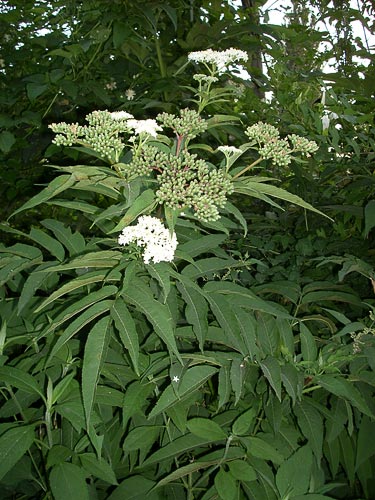Relatives
Sambucus ebulus L. - Dwarf Elder, Danewort.
Taxonomic position.
Family Sambucaceae Batsch ex Borkh., genus Sambucus L.Main synonyms.
Sambucus humilis Mill., S. herbacea Gilib., Ebulus humile GarckeMorphology and biology.
Perennial herbaceous plant with unpleasant odor 0.5-1.5 m tall. Stem straight, grooved, simple or slightly branched, glabrous or covered with sparse hairs. Stipules foliaceous, lanceolate or ovate. Leaf petioles 4-5 times shorter than blade. Leaves large, 5-20 cm long, of 9-11 leaflets, the latters lanceolate or oblong-lanceolate, long-acuminate, with oblique base. Leaflets glabrous or covered with sparse hairs along veins, especially beneath; decurrent. Leaflet margins serrate. Lower lateral leaflets petiolulate, upper ones sessile. Inflorescence terminal, an umbel-like flat large panicle on long peduncle, consists of 3 main branches, branching many times. Flowers with almond smell. Calyx teeth triangular, small. Corolla white or slightly pinkish or reddish outside. Stamens protruding up, with long filaments and purple anthers. Ovary glabrous, with short style. Fruits black, shiny, with red juice, about 4 mm long, with 3-4 stones. Stones ovate, triquetrous, convex on back, slightly transversally wrinkled. Flowers in May - July, fruits in August - September. Entomophilous. Zoochore.Distribution.
General distribution: Europe: Northern - Scandinavia (southern Sweden), Central, Atlantic - Madeira Island; Mediterranean; Balkan - Asia Minor region, Iran (northern, Caspian part of Iran). Former USSR: European part - the Dnieper River right side area (upper and middle course, usually in forest-steppe), Crimea, Moldova. When escaped wild, reaches southern Baltic states, the Upper Volga and the western Volga-Don regions. Caucasus - Ciscaucasia, Transcaucasia (Western, Eastern and Southern), Northern Caucasus (Dagestan), Talysh. Central Asia: mountainous Turkmenistan (Kopet-Dagh).Ecology.
In broad-leaved forests and in forest-steppe, in forest fringes, felled sites, at ravines and gorges, sides of streams and brooks, on slopes among shrubberies forms thickets. Weed in fields and gardens. In mountains up to the middle montane zone.Use and economic value.
Widely used in folk medicine. Fruits are used as a cathartic, they contain essential oil, malic, valeric and tartaric acid, tannic and bitter substances, anthocyanins. Seeds contain up to 27% fatty oil, which usually provides the cathartic effect. Inflorescences contain glycosides, decomposition of the latters results in cyanic acid, saccharose, invert sugars and essential oil. Branch bark contains emulsin and bitter substances. Bark with leaves is used as a cathartic and for outward application against rheumatism. Flowers (tea and dry) are used as a diaphoretic. Good early spring melliferous lant (large content of nectar in flowers).References:
Barbarich AI., Bradis EM., Visyulina OD., Volodchenko VS. 1965. Manual of plants of Ukraine. 2nd ed. Kiev: Urozhay. P.638. (In Ukrainian).Geideman TS. 1975. Manual of higher plants of Moldavian Soviet Socialist Republic. 2nd ed. Kishinev: Shtiintsa. P.455. (In Russian).
Shishkin BK., ed. 1958. Flora URSS. V.23. P.427-428. (In Russian).
Cherepanov SK. 1995. Vascular plants of Russia and adjacent states (the former USSR). St.Petersburg. 990 p. (In Russian).


